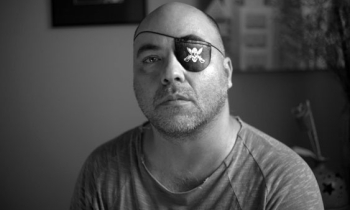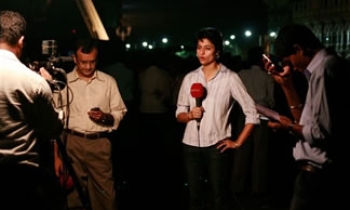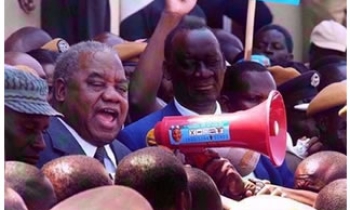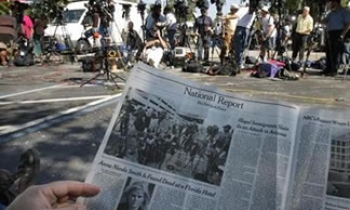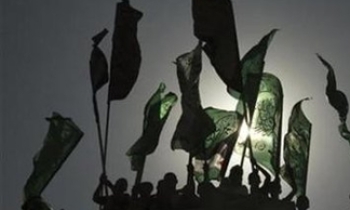SAGO, W.Va. -- Amid outrage over conflicting reports from the deadly Sago mine disaster, the mining company's top executive said Wednesday that he regretted allowing family members to believe for hours that their loved ones had survived.
A choked-up Ben Hatfield, chief executive of International Coal Group Inc., said company officials mistakenly allowed family jubilation "to go on longer than it should have" over erroneous reports that the miners were alive.
"We sincerely regret the manner in which events unfolded this morning," said Hatfield, who blamed "miscommunication" for the stunning and heartbreaking turn of events early Wednesday.
"I don't think that anyone had a clue how much damage was about to be created and we truly regret that," he said.
Hours later Wednesday night, about 200 people from the towns surrounding the mine gathered for a candlelight vigil.
The one miner who survived, Randal McCloy Jr., 27, was in critical condition in a Morgantown hospital with a collapsed lung and dehydration but showed no signs of brain damage or carbon monoxide poisoning, a doctor said.
Hatfield's remarks provided the first, partial explanation of what happened after rescue teams reached the miners. National news reports--including television reports by CNN and Fox News and stories in early editions of the Chicago Tribune, New York Times, Washington Post and other daily papers--told of the seemingly miraculous survival of 12 miners who had been trapped underground for more than 41 hours.
Three hours later, though, the joyous celebrations and the pealing of bells at the Sago Baptist Church abruptly ended as company officials shocked waiting family members and friends with the news that 11 of the 12 remaining miners were dead. The body of a 13th miner had been found earlier Tuesday night.
The grim task of piecing together what happened--and what went wrong--began Wednesday.
The cause of the explosion early Monday that killed the miners is still not known, Hatfield said. The miner whose body was found first was killed by the blast, but the cause of death of the other 11 remains unknown. How long the huddled miners survived was not clear.
Beyond that, though, there is confusion about the critical three hours between the rescuers' discovery of the miners and the disclosure to the families of their fate. No one apparently knows who spread the erroneous information. Unidentified people showed up at a church, supposedly telling those gathered there that rescued miners were on their way. All of this, as well as the hunger for a happy ending, fanned hours of journalistic fiction.
Hatfield said rescue teams reported finding 12 miners alive Tuesday night at 11:45 p.m. EST. Moments later the news spread via "stray cell phone conversations," he said. West Virginia Gov. Joe Manchin III, who lost an uncle in a 1968 mine disaster and who earlier Tuesday said it would take a miracle to find the miners alive, heard the news at the Sago Baptist Church.
"I was sitting with families and speaking with family members. There's two rooms in the church and when one room broke out in euphoria and everyone saying `What happened, what happened?'--that's when someone said, `They found them, they're alive,'" Manchin recalled. "I looked at our communications people and I looked at my security and said, `Have we had that confirmed, do we know anything about that?' And they said, `No.'"
Then there was a stampede to door and the church bells started ringing. The gloom that had settled over this small mining community suddenly gave way to joy, with men giving each other bear hugs and people shouting "Praise the Lord."
"They [families] kept saying `12 are alive, 12 are alive.' I looked at my detachment again and I said, `Have we confirmed that?' And we didn't," Manchin said.
After praying for more than two days for a miracle, there was no stopping this miracle, even if it wasn't true. Within minutes--at 11:52 p.m. EST--The Associated Press issued an alert, reporting family members as saying the 12 miners were alive. There was no confirmation from International Coal Group, which remained silent for the next three hours. Subsequent reports would attribute the news to family members, most of them unnamed.
And AP quoted the governor as saying, "They told us they have 12 alive."
Even among the celebrations there was confusion. Family members at the church said "outsiders" came in to say the miners were being brought there. No one knew who those people were.
Manchin said he left immediately for the mine and heard there were some "confusions" and "misstatements." But when asked before leaving the church if he could confirm the miners were alive, Manchin replied, "I said miracles do happen."
By midnight the first of the news stories would move, including a Tribune story in two early editions, under the headlines "12 found alive in coal mine" and "12 miners rescued." Those editions totaled 373,000 copies. Newsday called it "Miracle in the Mine." The Rocky Mountain News said, "They're Alive!"
Within the half-hour, Hatfield knew he had a problem. The report that the miners were alive was followed at 12:30 a.m. by news that only McCloy had survived. Hatfield then wished for his own miracle, telling reporters Wednesday afternoon that he "clinged to the hope that the other 11 might be comatose."
Hatfield said he did not know then whether the dead could number two or 12. "We didn't believe there was any productive benefit" to giving people inconclusive information. So the misinformation lived on. An hour later, at 1:38 a.m., the deaths of 11 miners were confirmed. Still, there was no public statement from the company.
Hatfield, who said he had no idea who spread the erroneous word, said he contacted the state police at 1 a.m., telling them to notify clergy at Sago Baptist Church to tell waiting families that "initial reports may have been inaccurate." That never happened. By 2:30 a.m., Hatfield said the company had completed a statement that he would soon deliver at the church.
When asked what he would have done differently, Hatfield said, "I would have personally gone to the church . . . to say something may be wrong here."

